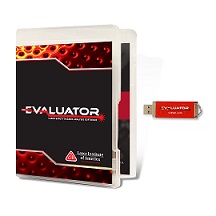 Orlando, FL (Jan. 29, 2016) – You asked and LIA responded! After the inception of the web-based Laser Safety Hazard Analysis System, The Evaluator, LIA created an alternative platform of the product – the Desktop Evaluator – to further meet the specific needs of Laser Safety Officers (LSOs) in the field.
Orlando, FL (Jan. 29, 2016) – You asked and LIA responded! After the inception of the web-based Laser Safety Hazard Analysis System, The Evaluator, LIA created an alternative platform of the product – the Desktop Evaluator – to further meet the specific needs of Laser Safety Officers (LSOs) in the field.
Unlike the web-based Evaluator, the Desktop Evaluator will be available for purchase on a USB drive, from which users can download the software to their computer. Once it is stored on users’ PCs, LSOs will be able to perform a number of repeated calculations based on the ANSI Z136.1 American National Standard for Safe Use of Lasers – including maximum permissible exposure (MPE), optical density (OD), nominal ocular hazard distance (NOHD), nominal hazard zone (NHZ) and laser hazard classification – without worrying about being connected to the internet. This feature will be especially beneficial for military users whose firewalls often restrict continuous access to online content.
The format of the Desktop Evaluator most closely resembling the advanced subscription level of the web-based Evaluator, continues LIA’s tradition of offering users an easy and seamless experience. The program’s accompanying User Guide, located in the Help menu, provides an overview of the program, from explanation of how to perform an evaluation to parameter descriptions and calculated results. Additionally, you can double-click any input parameters for an instant definition.
Similar to the web-based Evaluator, Desktop Evaluator users will be able to effortlessly switch between CW, Single Pulse, or repetitively pulsed lasers, as well as adjust the beam profile (circular, elliptical or rectangular). This simplified format allows LSOs to record a number of variables in the left-side panel – including wavelength, pulse width, focal length and more – which will yield final calculations on the right-side panel. In addition, intermediate calculations will be displayed throughout the process. The Desktop Evaluator also provides the classification of the laser and safety calculations for the eye and skin, including MPE, NOHD, NHZ, OD, Specular NHZ and Diffuse NHZ. Once these safety calculations are completed, users can print the report or save the information to a file for later review.
“The Evaluator Laser Hazard Analysis Software will benefit LSOs or companies that work with sensitive or classified laser systems where calculations must be kept within the control of the user,” according to LIA’s Education Director, Gus Anibarro. “This software is a standalone product, simple to use and simple to load on a computer. It will serve as a nice addition to the tools that a Laser Safety Officer needs for verifying hazard calculations.”
To learn more about the Desktop Evaluator, and to purchase a copy for your company, visit: www.lia.org/store.
About LIA
The Laser Institute of America (LIA) is the professional society for laser applications and safety serving the industrial, educational, medical, research and government communities throughout the world since 1968. www.lia.org, 13501 Ingenuity Drive, Ste 128, Orlando, FL 32826, +1.407.380.1553.
###





